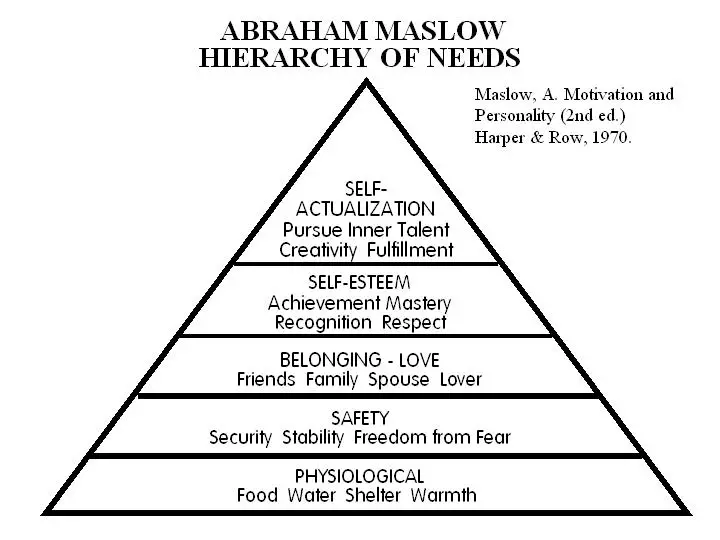Abraham Maslow, the renowned researcher and psychologists, proposed a “hierarchy of needs” that demonstrates the human needs in the shape of a pyramid. The base of the motivational order begins with the fundamentals of life. The life-sustaining physiological needs are considered as the most important human needs, which must be met before moving on to higher needs. Higher needs don’t seem as urgent and aren’t persuaded when lower needs are not met. It is portrayed with the largest and most fundamental levels of needs at the bottom, and the need for self-actualization at the top.
From Basic to More Complex Needs
Maslow’s hierarchy of needs is most often displayed as a pyramid. The lowest level or the base of the pyramid is comprised of the most pivotal needs, and as we continue up the levels, the needs start to seem more complex.
The base of the pyramid start from physiological needs that is vital for survival, such as food, water, warmth and sleep. Once these needs are met, the next level comprises of needs for security and safety.
Progressing up the pyramid, the needs start to get more complex. The third level is social needs that include the need for sense of belonging and love. Further up the pyramid is a person’s need for self-esteem and recognition. The need for self-actualization is at the very top of the pyramid.
Types of Needs
Maslow believed that needs played a major role in motivating behavior. He classified the first four levels of the pyramid, physiological, security, social and esteem needs, as deficiency needs (also called D-needs). Meaning, these needs are caused due to deprivation, and it’s extremely important for the lower-level needs to be satisfied before moving on to upper levels. Satisfying these needs help to overcome deprivation and avoid unpleasant feelings and consequences.
Likewise, Maslow categorized the highest level of the pyramid as growth needs (also called B-needs). Growth needs do not arise because of deprivation, but rather from a desire to grow.
Different Levels of the Hierarchy of Needs

Physiological Needs
Physiological needs are the fundamental requirements for human survival. Human body cannot survive without meeting these requirements. These requirements include air, water, food and sleep, which are must-haves for metabolic functions of the body. Additionally, sex is also a physiological need, as it is important for the survival of the species.
Safety Needs
The second level of Maslow’s hierarchy of needs include safety and security needs such as financial security, personal security, well-being and health. Although not extreme must-haves compared to the vital requirements of human survival, safety needs need to be fulfilled for a person to live without stress and worry.
In the absence of physical safety, like in situations of war and natural disaster and in cases of family violence and childhood abuse etc., a person might experience post-traumatic stress disorder and trans-generational trauma transfer. Likewise in cases of economic crisis and lack of job opportunities, a person stresses over well being of himself and his family. Examples of security needs include health care, safe neighborhoods, shelter, insurances, saving accounts and so on.
Social Needs; Love and Belonging
The third layers of human needs are interpersonal and involve feelings of belongingness, love and affection. Maslow categorized these needs as less vital than security and physiological needs. Emotional bonds like family, friendship, intimacy and family help to fulfill these needs. These needs are particularly strong during childhood. In a nutshell, loving and being loved by others takes care of these needs.
Esteem Needs
Esteem needs include needs for personal respect, self-esteem, social recognition and accomplishment. After all three lower level needs are fulfilled, people need to engage themselves in activities that give them a sense of contribution, to feel self-valued, be it in profession or hobby.
Maslow further categorized esteem needs into two versions, a lower one and a higher one. The lower one is the need for the respect of others, the need for status recognition, fame, prestige and attention. The higher one is the need for self-respect, competence, need for strength, freedom, independence and self-confidence. The higher version ranks further above than the lower needs. Deprivation of these needs can lead to weakness and helplessness.
Self-actualization
This level of need pertains to what a person’s full potential is and realizing that potential. Maslow describes this desire as the desire to become more and more of what one is, to become everything that one is capable of becoming. This is a broad definition of the need for self-actualization, but when applied to individuals the need is specific. “What a man can be, he must be.” This forms the basis of the perceived need for self-actualization.
As each individual is unique, the motivation leading to self actualization is different and thus leads people into different directions in life. Self actualization may be achieved through the works of art or literature by some, however, others might enjoy sports, corporate setting, or brainstorming tasks more.
it is important to understand that self actualization is not a perfect state of happily ever after, rather it’s the continual process of progress and improvement.
Maslow described self-actualization as
It refers to the person’s desire for self-fulfillment, namely, to the tendency for him to become actualized in what he is potentially.
The specific form that these needs will take will of course vary greatly from person to person. In one individual it may take the form of the desire to be an ideal mother, in another it may be expressed athletically, and in still another it may be expressed in painting pictures or in inventions. (Maslow, 1943, p. 382-383)
Characteristics
The fact that we, as human beings, are capable of self actualizing does not mean that we will do so, and even if we do, it might be to a limited degree. According to the estimation of Maslow (1970), only 2% of the total population will reach the state of self actualization. He was eagerly interested in the characteristics of those who managed to achieve their potential as a person.
After studying 18 superior profiles, which also included individuals like Albert Einstein and Abraham Lincoln, Maslow listed out 15 characteristics of a self-actualized person.
1. They perceive reality efficiently and can tolerate uncertainty;
2. Accept themselves and others for what they are;
3. Spontaneous in thought and action;
4. Problem-centered (not self-centered);
5. Unusual sense of humor;
6. Able to look at life objectively;
7. Highly creative;
8. Resistant to enculturation, but not purposely unconventional;
9. Concerned for the welfare of humanity;
10. Capable of deep appreciation of basic life-experience;
11. Establish deep satisfying interpersonal relationships with a few people;
12. Peak experiences;
13. Need for privacy;
14. Democratic attitudes;
15. Strong moral/ethical standards.
Applications
- Maslow’s hierarchy looks at the entire qualities of an individual. The qualities include physical, emotional, intellectual and social, rather than just a single aspect. This has helped to take a new approach when it comes to classroom management and teaching.
- While most tend to focus on the psychological needs of a person, Maslow’s hierarchy tells us that one most focus on the basic physiological needs before trying to meet the cognitive needs of an individual.
For example, a student cannot focus in his studies if he is hungry, thirsty or tired. Only after feeling physically and emotionally safe, can his other needs be met. - Another application of Maslow’s hierarchy in academic setting is the need for a student to feel valued and supported. This is not just applicable in a classroom setting. Let’s take an employee with a low self-esteem. He will not progress until is self-esteem is strengthened.
Critical Evaluation
Most researchers still do not support the idea of Maslow’s hierarchy of needs. Bridwell and Wahba are among them who believed there was little evidence for Maslow’s marking of these needs, and also argued against the hierarchical order these needs were placed in.
Another major criticism of Maslow’s theory was regarding his definition of self actualization. His research was based on limited amount of research. Findings of his biographical analysis is thought to be inadequate since he himself was the one who decided the respective individuals were self actualizing. Because his personal opinions were involved, his definition of self actualization must not be regarded as scientific fact.
His research on self actualization was done mostly on educated white males, Abraham Lincoln, Albert Einstein, Beethoven, Gandhi, including few self-actualized females like Mother Teresa and Eleanor Roosevelt. But, this still raises the question when it comes to population validity of Maslow’s findings.
Another criticism concerns Maslow’s theory that lower needs must be fulfilled before a person can go on to achieve higher needs. This isn’t always true. As in poorer, remote regions, people are still capable of love and belongingness even though they face difficulty in meeting the basic physiological needs.




